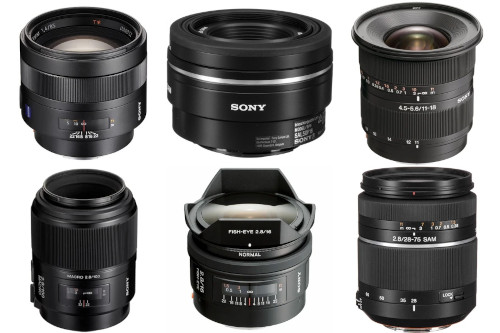
The 6 Best Lenses for the Sony A580
- Nathaniel Stephan
- Sony a580
- April 10, 2020
Table of Contents
The Sony A580 is a very good camera. If you do not own a lens or are shopping for a different lens, this page will talk about the top 6 lenses for your Sony SLT-A580.
Affiliate Advertising Disclosure
Outside the Shot is a participant in the Amazon Services LLC Associates Program, an affiliate advertising program designed to provide a means for sites to earn advertising fees by advertising and linking to Amazon.com.
As an eBay Partner, I may be compensated if you make a purchase. I also participate in affiliate advertising programs with KEH and Adorama. More can be found on the Affiliate Disclosure page.
More details are down further, but if you are pressed for time, below is the list:
- Standard Lens - Sony 50mm f/1.8 SAM DT
- Portrait Lens - Sony 85mm F1.4 ZA CZ
- Zoom Lens - Sony 28-75mm f/2.8
- Wide Angle Lens - Sony DT 11-18mm f/4.5-5.6
- Fisheye Lens - Sony 16mm f/2.8
- Macro Lens - Sony 100mm f/2.8 Macro
Below are the best Sony lenses broken down based on type of photography. There are alternative choices covering a range of costs.
Standard Primes
Sony 50mm f/1.8 SAM DT
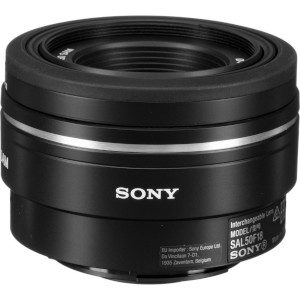
- Outstanding optics.
- Small and light weight.
- Can be difficult to find new.
- Smooth Autofocus Motor (SAM)
- Circular aperture.
See current price and more information on:
An impressive combo of compact size and minimal weight. Quiet and fast autofocus is supplied by a built-in motor..
A circular aperture allows you to stop down to f/4 and keep an almost completely circular aperture. This provides stunning bokeh and more freedom in controlling your depth of field.
Minolta Maxxum AF 50mm f/1.7
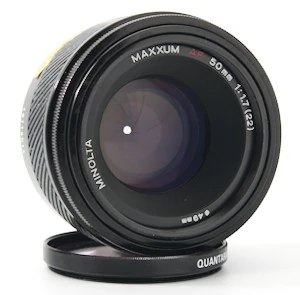
- Built-in lens hood.
- Amazing value.
- Light and compact.
- Widely available used.
- Coupled autofocus.
See current price and more information on:
This design was released by Minolta along with the unveiling of the A-mount. As a consequence of the age of the lens, the autofocus is powered by a motor built into the A580 camera body.
Mechanically coupled autofocus can be sluggish and fairly noisy. In the event that that’s not a huge concern for you the picture quality is outstanding. {The bokeh is pleasing and you’ll get a classic look to your images|You’ll end up with eye-catching bokeh and a classic rendering.
A further significant advantage of this lens is the cost. It is drastically more inexpensive than the Sony 50mm f/1.8 and on top of that may be the least expensive lens on the list.
Sony 50mm f/1.4
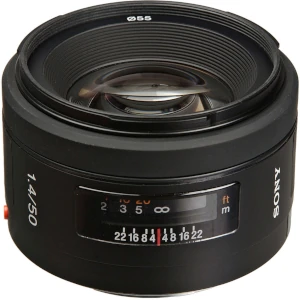
- Outstanding optics.
- Optical multi-coatings.
- Circular aperture.
- 55mm filter threads.
See current price and more information on:
A bit faster when compared to the Sony f/1.8, but that can actually be important when you are taking pictures without much light. That without a doubt comes at an additional cost.
It is still a lightweight and small lens that handles well on the A580 and can fit into nearly every camera bag.
A potentially cheaper solution is the Minolta AF 50mm f/1.4. Bear in mind that copies can be quite challenging to track down in good usable condition. It also uses physically coupled autofocus, which is louder and slower than lenses that contain built-in motors}.
Portrait & Telephoto Lens
Sony 85mm f/1.4 ZA
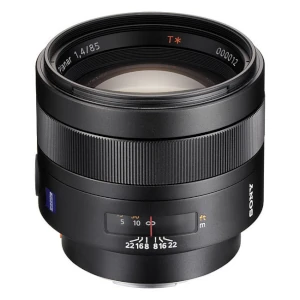
- Incredible bokeh.
- Excellent value used.
- T* coating to reduce flare and increase contrast.
- Astonishingly sharp wide open.
See current price and more information on:
Sony wanted to show off with this lens. Zeiss produced this lens. The ZA (Zeiss Alpha) means that Zeiss created the lens exclusively for the A-mount.
This lens is outstanding. Tack sharp corner-to-corner with vibrant colors that renders incredible portrait photos.
A potential downside is that it’s a lttle bit on the heavy side because it is built like a tank and it can feel slow to autofocus. Take into account, that you’ll encounter similar issues with any f/1.4 85mm.
Minolta Maxxum AF 85mm f/1.4
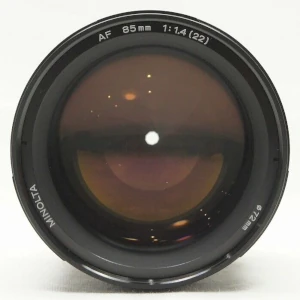
- Possible to find a good used deal.
- Superb image quality.
- Uses autofocus coupler.
- Double-Gauss design.
See current price and more information on:
In terms of cost, the lens sits between the other 2. Getting a used copy in usable condition will likely be a challenge as a result of a limited supply available.
The lens does have autofocus, but it uses a mechanical coupler and is driven by an in-camera body motor. This makes it slow to autofocus and relatively noisy.
A Double-Gauss design is older and contains 6 lens elements. An upsiade to this is that images possess a classic look that cannot be made by contemporary lenses that contain a lot more elements.
Sony A580 Zoom Lenses
Sony 28-75mm f/2.8
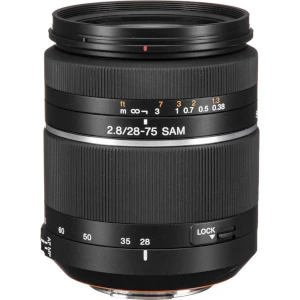
- Very usable zoom range.
- Great value used.
- Constant aperture.
- Smooth Autofocus Motor (SAM).
See current price and more information on:
A fast zoom lens that is perfect for night events, travel, indoor shooting, and family photos. It’s a well built lens with fairly quiet autofocus.
The lens often gets compared to the legendary Zeiss 24-70mm lens, but it is close to half the weight and less expensive. Both create pro results.
Sony 55-200mm f/4-5.6 SAM DT
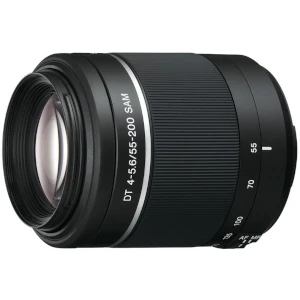
- Telephoto zoom range.
- Great for portrait or wildlife photography.
- Smooth Autofocus Motor (SAM).
- Inexpensive.
See current price and more information on:
A more affordable selection that can still produce great results. It’s not a pro lens, therefore assuming that you don’t need high end technology, it is a very good lens.
For a mid-range telephoto zoom, it gives you an excellent zoom range for capturing images of children outdoors, sports, and wildlife.
Image sharpness is very good and the autofocus is quick. The lens is made out of plastic, which aids in minimizing weight.
Sony 75-300mm f/4.5-5.6
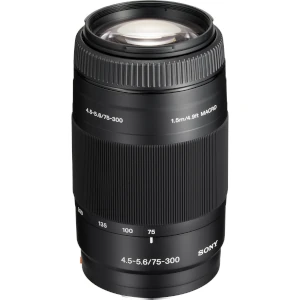
- Super telephoto zoom lens.
- Great for portrait or wildlife photography.
- 2.81 inches in diameter and 4.81 inches long.
- 55mm filter threads.
See current price and more information on:
This qualifies as a super-telephoto lens due to the zoom range. It’s an excellent affordable selection for when you want a lens with lots of reach.
The lens is 4.8 inches (12.2 cm) long, 2.8 inches (7.1 cm) in diameter, and comes in at 1 pound 2 ounces (510g). While not light, many pro telephoto primes and zooms are many times heavier than that.
For a bit better capabilities take a look at the Sony 70-300mm f/4.5-5.6 SSM ED G-Series, but plan on paying approximately twice as much.
Wide Angle Lens
Sony DT 11-18mm f/4.5-5.6
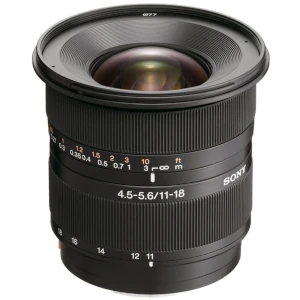
- Has a aspherical lens elements.
- Optical multi-coatings.
- Great value when purchased used.
- Circular aperture.
See current price and more information on:
Great quality for the price if you want to be able to take outstanding wide pictures that standard kit zooms cannot take. Distortion, especially of straight vertical lines is very low or non-existent unless you are intentionally trying to create an distorted perspective.
As well as being outstanding at taking spectacular landscapes, it’s also an ideal lens to travel with. The angle of view is wide enough so when you see something you’ll be able to get everything in frame.
Sony 20mm f/2.8
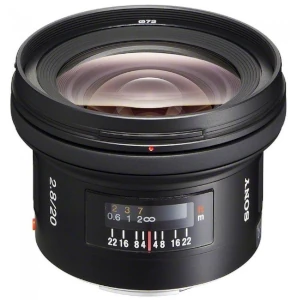
- Great for landscapes and architecture.
- Coated optics for clarity and definition.
- Rear focusing system for fast autofocus response.
- 72mm filter threads.
See current price and more information on:
A well engineered lens that does an outstanding job of minimizing lens distortion. Additionally, quite a lot of energy has been done to reduce internal reflections and flare.
The result is a fantastic lens that is very good for astrophotography, architecture, and landscape photography. The lens has a rear focusing system which means the front will not rotate so you won’t have any problems using a circular polarizer or another filter.
Tokina AT-X 11-16mm f/2.8 DX II
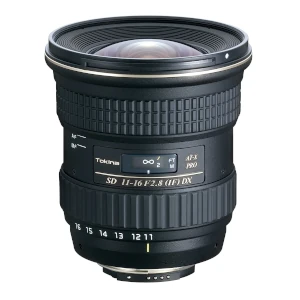
- Wide angle zoom lens.
- Hardened Alumite finish.
- Advanced optical coatings.
- All metallic moving parts.
- Designed for APS-C Sensors.
See current price and more information on:
It does not have very fast autofocus, but the MF/AF focus clutch helps make it a great choice for manual focusing. A push or pull of the focus ring switches the lens from auto to manual focus or vice versa.
The Tokina has a larger aperture than the Sony 11-18mm, which isn’t a major issue for architecture or landscape images. Where you will notice a big difference is during astrophotography. That’s a circumstance where you’d want to take advantage of the 1-2 stop advantage the Tokina offers.
Fisheye
Sony 16mm f/2.8 Fisheye
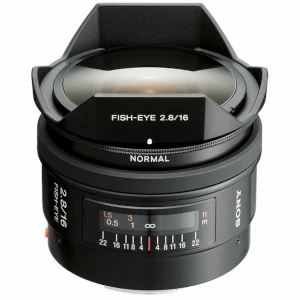
- Sharp corner-to-corner.
- 4 built-in filters: Normal, 056, B12, A12.
- 8 inch minimum focus distance.
- Aspherical and Extra-low Dispersion elements.
See current price and more information on:
Having built-in filters is a good addition because the lens has a petal-style hood which prevents a lens filter from being mounted to the front of the lens.
- 056 - Accented contrast for black and white photos.
- B12 - Correct color by eliminating red tones.
- A12 - Correct color by eliminating blue tones.
This lens has almost everything you could need from a fisheye. You’ll get corner-to-corner sharpness without vignetting while still getting exaggerated distortion.
Rokinon 8mm f/3.5 Fisheye
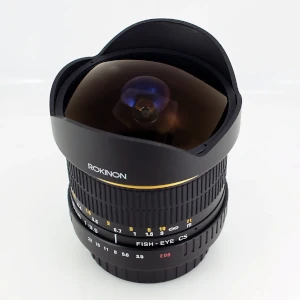
- Internal focus.
- 180 degree angle of view.
- Manual focus.
- Minimum focusing distance of 12 inches (0.3m).
- Designed for APS-C sensors.
See current price and more information on:
The lens features a large front which means lens filters cannot be used. It has a detachable petal-style hood that you’ll want to ensure that it is included if you order a pre-owned lens.
Construction quality is often hit or miss as a consequence of the very affordable price of the lens. A majority of buyers are really pleased with the photos they get. It is still important to extensively test the lens when you receive it to know for sure that it is not a bad copy.
Macro Lens
Sony 100mm f/2.8 Macro
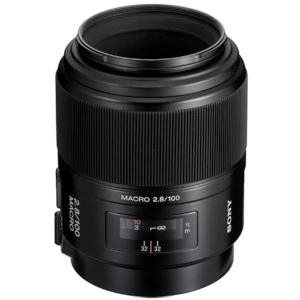
- 9 aperture blades.
- Focus range limiter.
- High contrast and resolution.
- 55mm filter threads.
See current price and more information on:
The optimal balance of working distance, size, and price for the Sony A580. The autofocus is somewhat noisy, but for shooting macro photos, manual focus is easier than using autofocus.
For the highest quality images at 1x magnification the lens needs to be stopped down. Doing that will also give you a greater depth of field, which is very important for macro photography.
Sony 50mm f/2.8 Macro
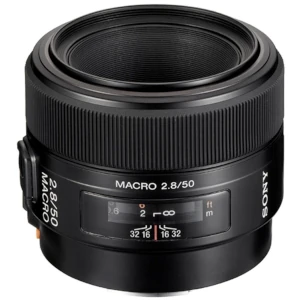
- 10.4 ounces (295g).
- Focus range limiter.
- Focus Hold button for full creative control.
- 55mm filter threads.
See current price and more information on:
A 50mm lens isn’t the best for 1:1 magnification due to how little working distance you will have. At 1:1 magnification, the front of the lens will end up being around 2 inches (5 cm) away from the subject.
This lens performs well at close-up, copy work, and tabletop photography. It enables you to get closer to a subject than a standard 50mm, and that’s perfect for nature photography if you need to fill the camera frame with a smaller sized subject, for instance a flower.
Tamron AF 90mm f/2.8 Di SP A/M 1:1 Macro

- Available in a variety of camera mounts.
- Improved resolution, chromatic correction, and optical coatings.
- Super Performance (SP)
- Focus clutch to switch between AF & MF.
See current price and more information on:
The focus ring feels great when manually focusing, and the lens also has autofocus. Closed down a couple of stops and you’ll get razor-sharp photos.
Additionally, be careful when ordering it as it is offered for a number of lens mounts.
Used A-Mount Camera Lens Prices
Pricing is continuously in flux. Over the past couple of years, interest in film photography has been climbing. Since there are Minolta 35mm film cameras that use the A-mount, some additional demand is added to the price of lenses.
The Sony A-mount also doesn’t have a major market share. Due to this fact, there are a smaller number of third party choices and the lenses manufactured by Sony are occasionally on backorder.
To find the lowest price, look at prices on a few sites. For used lenses, be prepared to buy when you see a great deal as they usually do not be available for long.
What Lens Mount Does the A580 Use?
The Sony A580 uses the Sony A-mount. It is also the same as the Minolta A-mount. This is due to the fact that Sony acquired Konica Minolta’s imaging division in 2006.
Minolta engineered the A-mount for the intro of interchangeable lens autofocus cameras in 1985. It’s still being supported by Sony to this day.
Standard Lens Cap Size
55mm filter threads are the most common, but honestly the sizes are all over the place. Previous Minolta lenses generally have 49mm filter threads.
You will also find numerous lenses that have much larger filter threads than 55mm. It’s not hard to find to see 72mm or 77mm. It would have been helpful if Sony used only 2 or 3 different filter thread sizes.


